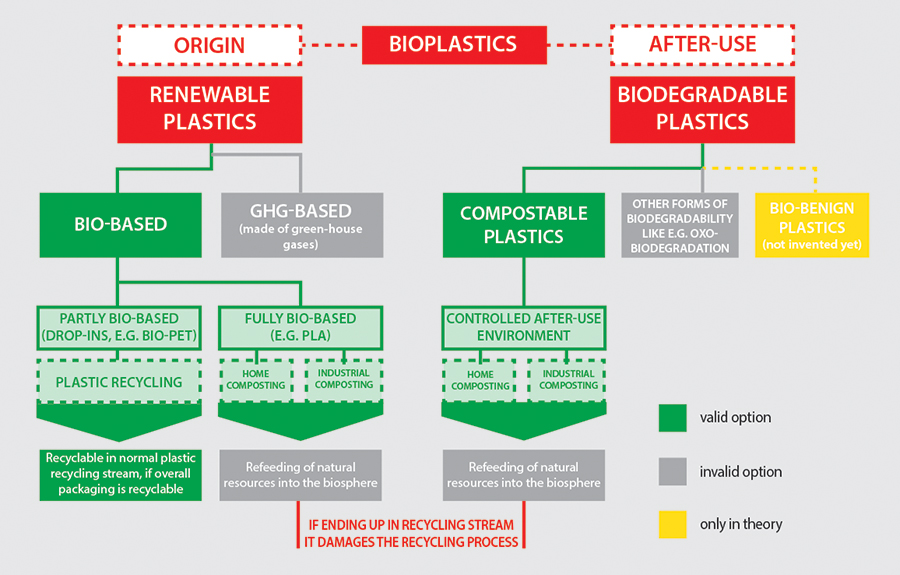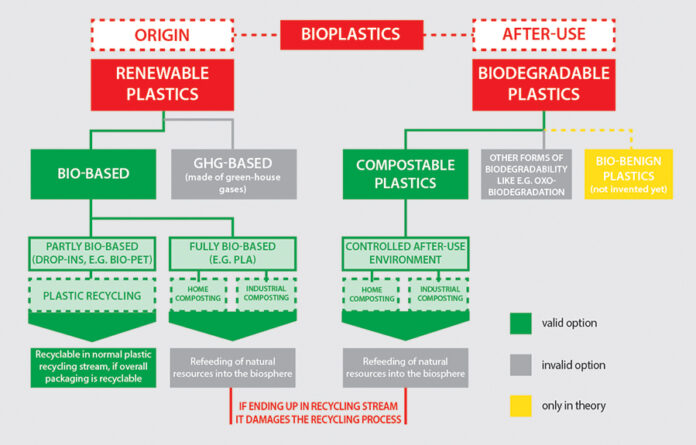By Carla Brown, Manager, Corporate Communications – Circular Economy Specialist,
Siegwerk Druckfarben AG & Co.
A note from RadTech:
The RadTech Sustainability Committee is embarking on our group’s sustainability journey, and we thank Carla Brown, manager, Corporate Communications – Circular Economy Specialist, Siegwerk Druckfarben AG & Co., for sharing her work in a series of modules UV+EB Technology will publish throughout the year. This is the second installment.
Design 4 Less is not simply about whether the same results could be achieved with less packaging material. It also is about designing packaging with fewer petrochemical contents by increasing the biorenewable contents within the packaging components. Biorenewable and biodegradable are two terms that resonate pretty well with sustainability. Let’s have a closer look at what they mean. Readers will see that a term with the prefix “bio” is not intrinsically a sustainable option.
Biorenewable and Biodegradable: Inks
Biorenewable content (BRC) in inks and coatings is derived from tree, plant, insect and/or animal materials. In pre-plastic times, polymers from natural sources already were used in printing inks (and, partially still are) – take, for example, rosin or shellac. However, inks using these components have certain performance limits and usually cannot meet today’s demand. Now it is up to the industry to revitalize the usage of bio-based components in inks combining performance and renewability. Increasing the amount of bio-renewable content in inks and coatings on packaging can help to mitigate the environmental impact of that packaging, including the use of petrochemicals and the leakage of microplastics.
Already today, several inks and coatings have a high degree of BRC. For some systems, it is easier than for others. Examples of inks, OPVs and barrier coatings with high and transparent bio-renewable content may include (reaching up to 80% renewable content) the following:
- Solvent-based inks (nitrocellulose)
- UV inks (bio-based acrylates)
- Water-based inks (bio-based acrylics)
- Conventional offset inks (vegetable oil and natural resins)
- Barrier coatings with maximized renewable content
Printing inks are a mixture of various substances: pigments, binders, additives and solvents. Some of these substances can be made from biorenewable resources. Can how much BRC is in a product be measured? Yes, the share of biorenewable materials in a substance or a product can be exactly determined according to several scientifically agreed methods, including – for example – isotope testing.
In order to be biodegradable, inks need to decompose to harmless molecules after the use cycle. However, printing inks for packaging typically have to fulfill technical specifications to be able to survive the use cycle of the packaging and remain unchanged. Inks must, therefore, be at least partly resistant to decomposition processes. While some substances, like polymeric binders, may decompose under such conditions, the pigments (and inorganic fillers) used in the printing inks are very stable. These opposing properties (stability vs. decomposition) need to be overcome before truly biodegradable inks can be discussed. For the time being, a considerable part of the dry ink film typically must be considered non-biodegradable under the parameters set by most standards.
Let’s keep in mind that ink makes up only a small part of the final packaging. For this reason, it is considered more important to focus on the biorenewable or biodegradable nature of the packaging itself. This is enabled by printing inks formulated in such a way that they do not disturb the composting process of printed packaging material.
Biorenewable and Biodegradable: Packaging
When are bioplastics a valid sustainable alternative to conventional plastics? Considering the global shift toward sustainability, using bioplastics as a renewable source is an attractive option for many. However, there are challenges to overcome. So, what are bioplastics, and under which circumstances do they offer a sustainable alternative to conventional plastics?
Renewable vs. biodegradable plastics*
According to European Bioplastics and the Institute for Bioplastics and Biocomposites, a plastic material is defined as bioplastic if it is either bio-based, biodegradable or features both properties. Thus, bioplastics is an umbrella term for two different aspects: The origin of the material (i.e., based on renewable materials) and the after-use pathways (e.g., managed biodegrading through composting).
The specification in terms of origin indicates if the plastic material is based on biological or fossil feedstock. The so-called renewable plastics describe plastic in which constitutional units are totally or partly made from renewable material. This includes bio-based plastics as well as plastics made of greenhouse gases (GHG) like carbon dioxide; the latter, however, still represents a niche in today’s technology. Bio-based plastics are considered to play a significant role to de-fossilize the plastics system, which is an imperative in the Circular Economy.
The after-use perspective is important because not all bio-based plastics are biodegradable. There are, in general, two broader types of bio-based plastics which determine the after-use perspective:
- Partly bio-based (‘drop-ins’): These plastics have chemically identical properties to their non-renewable versions and therefore can be mixed easily with conventional plastics. Drop-ins are not biodegradable but can be recycled in the plastic recycling stream.
- Fully bio-based: These plastics are fully comprised of renewable (often starchy) sources. Fully bio-based plastics are biodegradable and can be disposed of in the composting waste stream.
Where are the challenges?
For bio-plastics, biodegradation has to mean controlled composting. Fully bio-based plastics do not biodegrade sufficiently in an uncontrolled environment, e.g. when leaked into nature. Rather, they need a controlled environment of either industrial or home composting. Industrial composting needs a managed waste stream, whereas home composting needs enough space, knowledge and personal effort.
Fully bio-based plastics harm the recycling process. If compostable plastic ends up in the recycling process, it causes harm to the extruder (the machinery used to melt down the plastic substrate). As consumers are not able to differentiate between conventional plastic and fully bio-based plastic, they might not dispose of the packaging correctly. Therefore, there would be a need for clear consumer information about the correct disposal and waste stream.
Research has shown that packaging (imprecisely) labeled as biodegradable increases littering behavior among consumers. To no surprise: It is a tall order to expect consumers to correctly assess the limits of biodegradability.
“Stealing” from the plastic waste stream. Depending on the country, recycling rates often are much higher than composting rates. In cases where a packaging structure today has a high likelihood of being recycled, it ideally should not be designed using a non-recyclable, bio-based plastic destined for the compostable stream. Some composters follow the practice of sorting out compostable packaging as they see a risk in it minimizing their output quality.
When are Bioplastics a Valid Circular Packaging Solution?
Drop-in bioplastics are a valid option for plastic packaging that is designed for the recycling stream, allowing the reduction of finite resources while the packaging remains recyclable. Fully bio-based plastics can be used for packaging that currently is unlikely to be recycled. However, this needs clear labeling stating that the packaging should be composted and is not suited for recycling. This then has the potential to move from a conventional plastic that often is discarded as residual waste to a fully bio-based plastic packaging that has a circular after use in composting (Figure 1). The worst case would be that the packaging remains part of the non-circular residual waste stream but is at least de-fossilized. Examples include single-serving sachets (e.g. for condiments) and coffee caps.

Bioplastics have their limitations as of today when applying a differentiated well-considered assessment. A circular packaging industry will not be created without driving reuse and high-quality recycling as much as possible.
The reality is that leakage is likely to remain significant and must be addressed. Even in the United States and Europe, with advanced collection systems, 170,000 tons of plastics leak into the ocean each year. In this context, the potential of bioplastics should be recognized as motivation to drive game-changing innovation in material sciences to move closer to truly biodegradable (bio-benign) plastics. Furthermore, investing in expanding the composting infrastructure would be an essential strategy to mitigate the negative effects of leakage into nature.






